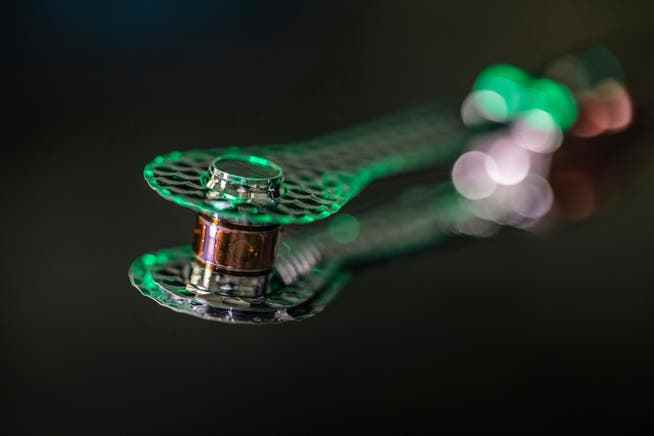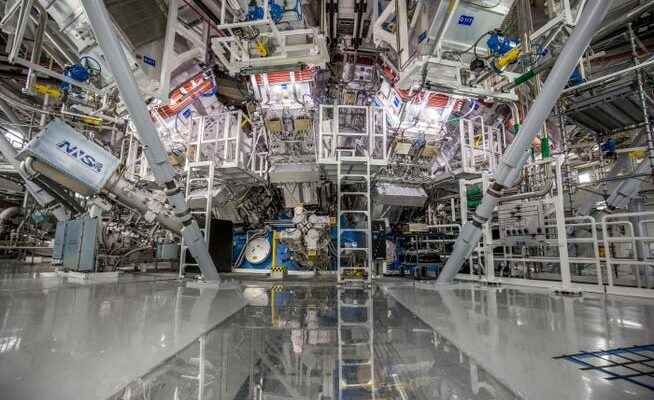A nuclear fusion experiment in the USA has achieved a positive energy balance for the first time. However, anyone hoping for an early solution to our energy problems is wrong.
The Target Chamber of the National Ignition Facility. This is where the 192 lasers converge, compressing and heating the fuel.
Lawrence Livermore National Laboratory (LLNL) director Kimberly Budil remained surprisingly honest even in the hour of success. The construction of an electricity-supplying nuclear fusion reactor is still decades away, the physicist said at a press conference on Tuesday. In doing so, she put a scientific breakthrough into perspective that her boss, US Secretary of Energy Jennifer Granholm, had announced a few minutes earlier.
In early December, after decades of research, scientists at the LLNL managed for the first time to generate more energy than was previously used to ignite the fuel through the controlled fusion of atomic nuclei. Budil’s cautious words make it clear that the researchers still have a long way to go before they can help controlled nuclear fusion achieve a breakthrough not only scientifically, but also technologically. In a field that tends to overpromise, this sobriety is comforting.
Nuclear fusion does not produce any fission products
Nuclear fusion is the process that makes our sun shine. Inside, hydrogen nuclei fuse to form helium nuclei. As with nuclear fission, nuclear fusion also releases energy that is to be converted into electricity in a future fusion reactor. The advantage over a conventional reactor would be that there would be no long-lived radioactive fission products that would have to be disposed of.
However, fusing atomic nuclei is much more complex than splitting them. This is because the atomic nuclei are electrically charged and repel each other. To overcome the forces of repulsion, the Lawrence Livermore National Laboratory relies on the concentrated power of 192 high-power lasers.
The laser beams generated by the National Ignition Facility are directed into a cylindrical cavity. There is a ball about the size of a peppercorn that is filled with a mixture of deuterium and tritium. The cavity heats up and emits intense X-ray light, which vaporizes the shell of the fuel pellet. In turn, an inward shock wave forms, compressing and heating the fuel. If everything fits together – and there are many things that can go wrong – the plasma ignites. One fusion reaction follows the other until, ideally, the fuel is completely consumed.
Not everything came together on December 5th, but a lot did. After being hit by a laser, the plasma ignited and produced 3.15 megajoules of fusion energy. True, only a small percentage of the fuel burned. However, that was enough to generate 1.5 times as much energy as was previously put into the cavity. The experiment at the LLNL is the first in the world to show a positive energy balance.
Scientifically, this is a milestone. At the same time, the experiment also shows how far away we are from an electricity-producing power plant. The energy balance is only positive if the considerable losses of the laser system are neglected. This has an energy consumption of 300 megajoules, of which only 2.05 megajoules end up in the cavity and initiate nuclear fusion. The rest is lost beforehand in various conversion processes.

In this cylindrical cavity, the fuel pellet is made to implode.
The laser system at the National Ignition Facility dates from the 1980s and is outdated, says nuclear physicist Markus Roth from the Technical University of Darmstadt. It’s not just inefficient. It can also only fire one shot per day. In a future fusion power plant, however, several fuel pellets would have to be ignited per second in order to ensure a continuous flow of energy.
These are not the only technical challenges that await fusion researchers in the coming years. In order to generate electricity, the neutrons released during nuclear fusion must be captured. This is primarily a material-technical problem. In addition, the fuel tritium is rare. A fusion reactor must therefore “breed” the hydrogen isotope itself if it is to supply electricity on a permanent basis. There are ideas for this. However, these have not yet been tested on an industrial scale.
So far, energy production has only been a sideline of research
The National Ignition Facility is not the ideal place to advance the development of a commercial fusion reactor. This research facility reports to the National Nuclear Security Administration and is primarily used to simulate nuclear weapon explosions. Nuclear fusion to generate energy was always just a sideline of research.
It remains to be seen whether that will change now. The American government may spend a lot of money to speed up the development of laser-induced nuclear fusion. However, private companies may also provide the necessary tailwind. Some of the former employees of the National Ignition Facility have since been hired by startups. The former chief scientist now works for the Germany-based company Focused Energy. One is convinced that more can be achieved with modern laser technology than at the National Ignition Facility, says Roth, one of the co-founders of Focused Energy.
On the one hand, Focused Energy builds on a more efficient laser system. On the other hand, the researchers want to decouple the compression and ignition of the plasma. The plasma should only be heated when it has reached its maximum density. According to Roth, this timing promises a greater energy yield. The goal is to build a demonstration facility over the next ten years that will generate 100 to 200 times the energy needed to ignite the plasma. The next step would then be a commercial, electricity-producing fusion power plant.
Several paths lead to nuclear fusion
Focused Energy isn’t the only company looking to break through nuclear fusion. Dozens of startups have sprung up in recent years, some with significant venture capital. The majority of them rely on a different form of nuclear fusion. The plasma is held together by strong magnetic fields and then heated to 150 million degrees.
Nuclear fusion by magnetic confinement has been tried many times. Nevertheless, in the best-case scenario, only 65 percent of the energy used was recovered. This is only to change with the international experimental reactor Iter, which is currently being built in France. This should generate ten times as much energy as is needed to heat the plasma.
Nuclear fusion using a magnetic confinement has a development lead of thirty years, says Roth. But recent successes at the National Ignition Facility show that the learning curve for laser-induced nuclear fusion is steep. Roth welcomes the fact that there are now several promising paths to nuclear fusion. It’s like being in a flower meadow. The more flowers that grow there, the greater the chances that one will bloom.
Follow the science editors of the NZZ Twitter.
